
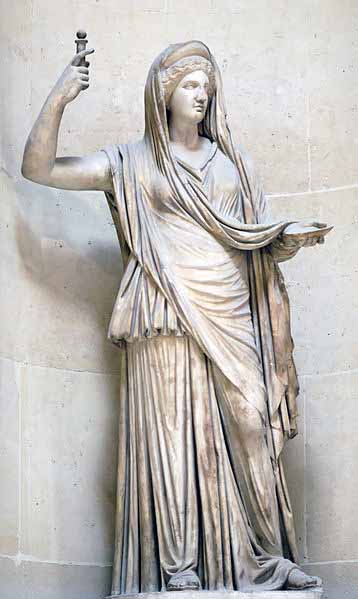


�Hera was the wife and one of three sisters of Zeus in the Olympian pantheon of Greek mythology and religion. Her chief function was as the goddess of women and marriage. Her counterpart in the religion of ancient Rome was Juno. The cow and the peacock were sacred to her. Hera's mother was Rhea and her father Cronus.
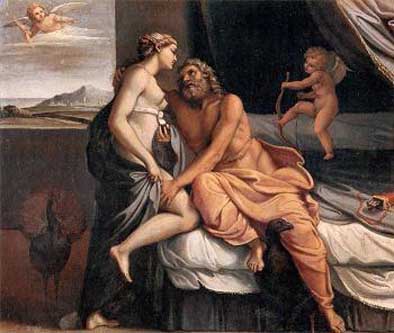
Portrayed as majestic and solemn, often enthroned, and crowned with the polos (a high cylindrical crown worn by several of the Great Goddesses), Hera may bear a pomegranate in her hand, emblem of fertile blood and death and a substitute for the narcotic capsule of the opium poppy. Hera was known for her jealous and vengeful nature, most notably against Zeus's lovers and offspring, but also against mortals who crossed her, such as Pelias. Paris offended her by choosing Aphrodite as the most beautiful goddess, earning Hera's hatred.
Unlike some Greek gods, such as Zeus and Poseidon, Hera's name is not analyzable as a Greek or Indo-European word. She therefore seems to be a survival of a pre-Greek "great goddess" figure - perhaps one of the powerful female divinities of the Minoan pantheon, or of some unidentified pre-Greek ("Pelasgian") people.
Hera's importance in the early archaic period is attested by the large building projects undertaken in her honor.
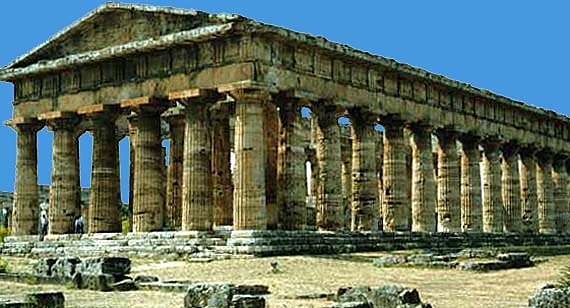
Hera's importance in the early archaic period is attested by the large building projects undertaken in her honor. The temples of Hera in the two main centers of her cult, the Heraion of Samos and the Heraion of Argos in the Argolid, were the very earliest monumental Greek temples constructed, in the 8th century BC.
Sometimes this devolved role is as clear as a simple substitution can make it. According to the Homeric Hymn III to Delian Apollo, Hera detained Eileithyia, to already prevent Leto from going into labor with Artemis and Apollo, because the father was Zeus. The other goddesses present at the birthing on Delos sent Iris to bring her. As she stepped upon the island, the divine birth began. In the myth of the birth of Heracles, it is Hera herself who sits at the door instead, delaying the birth of Heracles until her protegˇ, Eurystheus, has been born first.
The Homeric Hymn to Pythian Apollo makes the monster Typhaon the offspring of archaic Hera in her Minoan form, produced out of herself, like a monstrous version of Hephaestus, and whelped in a cave in Cilicia (Iliad, ii. 781-783). She gave the creature to Gaia to raise.
At Olympia, Hera's seated cult figure was older than the warrior figure of Zeus that accompanied it. Homer expressed her relationship with Zeus delicately in the Iliad, in which she declares to Zeus, "I am Cronus' eldest daughter, and am honorable not on this ground only, but also because I am your wife, and you are king of the gods."
Though Zeus is often called Zeus Heraios ("Zeus, consort of Hera"), Homer's treatment of Hera is less than respectful, and in late anecdotal versions of the myths (see below) she appeared to spend most of her time plotting revenge on the nymphs seduced by her Consort, for Hera upheld all the old right rules of Hellene society and sorority.
Hera was born of Cronos and Rhea, and was abruptly swallowed after birth due to a prophesy that one of Cronos's children will take over his throne. Zeus was spared and when he grew older he saved all of his siblings, then banished Cronos, because the gods were immortal and could not be killed.
Hera was especially worshipped, as "Argive Hera" (Hera Argeia), at her sanctuary that stood between the former Mycenaean city-states of Argos and Mycenae, where the festivals in her honor called Heraia were celebrated. "The three cities I love best," the ox-eyed Queen of Heaven declares (Iliad, book iv) "are Argos, Sparta and Mycenae of the broad streets." Her other main center of cult was at Samos. There were also temples to Hera in Olympia, Corinth, Tiryns, Perachora and the sacred island of Delos. In Magna Graecia, the temple long called the Temple of Poseidon among the group at Paestum was identified in the 1950s as a second temple there of Hera.
Greek altars of Classical times were always under the open sky. Hera may have been the first to whom an enclosed roofed temple sanctuary was dedicated, at Samos about 800 BC. (It was replaced later by the Heraion, one of the largest Greek temples anywhere.)
Earlier sanctuaries, whose dedication is less secure, were of the Mycenaean type called "house sanctuaries". Samos excavations have revealed votive offerings, many of them late 8th and 7th century, which reveal that Hera at Samos was not merely a local Greek goddess of the Aegean: the museum there contains figures of gods and suppliants and other votive offerings from Armenia, Babylon, Iran, Assyria, Egypt, testimony to the reputation which this sanctuary of Hera enjoyed and to the large influx of pilgrims - and a general reminder to us that Greek myths did not evolve in a cultural vacuum (Burkert 1998).
In Euboea the festival of the Great Daedala, sacred to Hera, was celebrated on a sixty-year cycle.In Hellenistic imagery, Hera's wagon was pulled by peacocks, birds not known to Greeks before the conquests of Alexander: Alexander's tutor, Aristotle, refers to it as "the Persian bird."
The peacock motif was revived in the Renaissance iconography that unified Hera and Juno, and which European painters have kept familiar to us (Seznec 1953). A bird that had been associated with Hera on an archaic level, where most of the Aegean goddesses were associated with "their" bird, was the cuckoo, which appears in mythic fragments concerning the first wooing of a virginal Hera by Zeus.
Her archaic association was primarily with cattle, as a Cow Goddess, who was especially venerated in "cattle-rich" Euboea. Her familiar Homeric epithet bo™pis, is always translated "cow-eyed", for, like the Greeks of Classical times, we reject its other natural translation "cow-faced" or at least "of cow aspect".
A cow-headed Hera, like a Minotaur would make a dark demon of fear. But on Cyprus, very early archaeological sites contain bull skulls that have been adapted for use as masks (see Bull (mythology)).
The pomegranate, an ancient emblem of the Great Goddess, remained an emblem of Hera: many of the votive pomegranates and poppy capsules recovered at Samos are made of ivory, which survives burial better than the wooden ones that must have been more common. Like all goddesses, Hera may be displayed wearing a diadem and be veiled.
There has been considerable scholarship, reaching back to Johann Jakob Bachofen in the mid-nineteenth century, about the possibility that Hera, whose early importance in Greek religion is firmly established, was originally the goddess of a matriarchal people, presumably inhabiting Greece before the Hellenes. In this view, her activity as goddess of marriage established the patriarchal bond of her own subordination: her resistance to the conquests of Zeus is rendered as Hera's "jealousy", the main theme of literary anecdotes that undercut her ancient cult. However, it remains a controversial claim that primitive matriarchy existed in Greece or elsewhere.
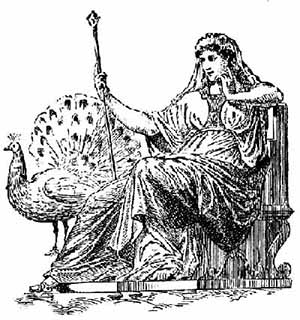
In Hellenistic imagery, Hera's wagon was pulled by peacocks, birds not known to Greeks before the conquests of Alexander: Alexander's tutor, Aristotle, refers to it as "the Persian bird." The peacock motif was revived in the Renaissance iconography that unified Hera and Juno, and which European painters have kept familiar to us (Seznec 1953). A bird that had been associated with Hera on an archaic level, where most of the Aegean goddesses were associated with "their" bird, was the cuckoo, which appears in mythic fragments concerning the first wooing of a virginal Hera by Zeus.
Her archaic association was primarily with cattle, as a Cow Goddess, who was especially venerated in "cattle-rich" Euboea. Her familiar Homeric epithet boopis, is always translated "cow-eyed", for, like the Greeks of Classical times, we reject its other natural translation "cow-faced" or at least "of cow aspect". A cow-headed Hera, like a Minotaur would make a dark demon of fear. But on Cyprus, very early archaeological sites contain bull skulls that have been adapted for use as masks.
The pomegranate, an ancient emblem of the Great Goddess, remained an emblem of Hera: many of the votive pomegranates and poppy capsules recovered at Samos are made of ivory, which survives burial better than the wooden ones that must have been more common. Like all goddesses, Hera may be displayed wearing a diadem and be veiled.
Hera presides over the right arrangements of the marriage and is the archetype of the union in the marriage bed, but she is not notable as a mother. The legitimate offspring of her union with Zeus is Ares, Hebe (the goddess of youth), Eris (the goddess of discord) and Eileithyia (goddess of childbirth). Hera was jealous of Zeus' giving birth to Athena without recourse to her (actually with Metis), so she gave birth to Hephaestus without him. (An alternate version discounts this and says Zeus and Hera were both parents of Hephaestus) Zeus and/or Hera herself were then disgusted with Hephaestus' ugliness and threw him from Mount Olympus. As another alternative version, Hera gave birth to all of the children usually accredited to her and Zeus together, alone by beating her hand on the Earth, a solemnizing action for the Greeks, or by eating lettuce.
Hephaestus gained revenge against Hera for rejecting him by making her a magical throne which, when she sat on it, didn't allow her to leave it. The other gods begged Hephaestus to return to Olympus to let her go but he repeatedly refused. Dionysus got him drunk and took him back to Olympus on the back of a mule. Hephaestus released Hera after being given Aphrodite as his wife.
Hera was the stepmother and enemy of Heracles, who was named "Hera-famous" in her honor; Heracles is the hero who, more than even Perseus, Cadmus or Theseus, introduced the Olympian ways in Greece. When Alcmene was pregnant with Heracles, Hera tried to prevent the birth from occurring by tying Alcmene's legs in knots. She was foiled by Galanthis, her servant, who told Hera that she had already delivered the baby. Hera punished Galanthis by turning her into an animal.
While Heracles was still an infant, Hera sent two serpents to kill him as he lay in his cot. Heracles throttled a single snake in each hand and was found by his nurse playing with their limp bodies as if they were a child's toys. The anecdote is built upon a representation of the hero gripping a serpent in each hand, precisely as the familiar Minoan snake-handling goddesses had once done. "The picture of a divine child between two serpents may have been long familiar to the Thebans, who worshiped the Cabeiri, although not represented as a first exploit of a hero". Later she stirred up the Amazons against him when he was on one of his quests.
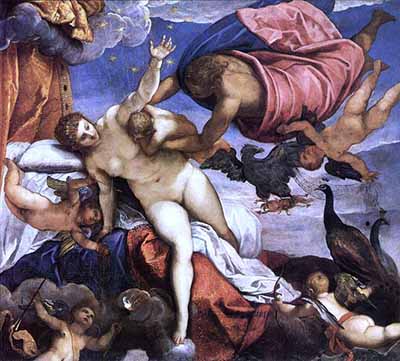
One account of the origin of the Milky Way is that Zeus had tricked Hera into nursing the infant Heracles: discovering who he was, she pulled him from her breast, and a spurt of her milk formed the smear across the sky that can be seen to this day. Unlike any Greeks, the Etruscans instead pictured a full-grown bearded Heracles at Hera's breast: this may refer to his adoption by her when he became an Immortal. He had previously wounded her severely in the breast.
Hera assigned Heracles to labor for King Eurystheus at Mycenae. She attempted to make almost each of Heracles' twelve labors more difficult.
When he fought the Lernaean Hydra, she sent a crab to bite at his feet in the hopes of distracting him. When Heracles took the cattle of Geryon, he shot Hera in the right breast with a triple-barbed arrow: the wound was incurable and left her in constant pain, as Dione tells Aphrodite in the Iliad, Book V. Afterwards, Hera sent a gadfly to bite the cattle, irritate them and scatter them. Hera then sent a flood which raised the water level of a river so much that Heracles could not ford the river with the cattle. He piled stones into the river to make the water shallower. When he finally reached the court of Eurystheus, the cattle were sacrificed to Hera.
Eurystheus also wanted to sacrifice the Cretan Bull to Hera. She refused the sacrifice because it reflected glory on Heracles. The bull was released and wandered to Marathon, becoming known as the Marathonian Bull.
Some myths state that in the end, Hera befriended Heracles for saving her from Porphyrion, a giant who tried to rape her during the Gigantomachy, and that she even gave her daughter Hebe as his bride. Whatever myth-making served to account for an archaic representation of Heracles as "Hera's man" it was thought suitable for the builders of the Heraion at Paestum to depict the exploits of Heracles in bas-reliefs.
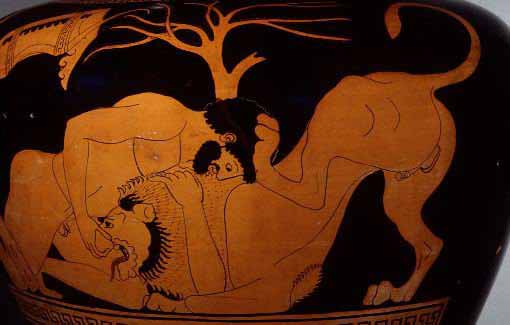
Hera assigned Heracles to labor for King Eurystheus at Mycenae. She attempted to make almost each of Heracles' twelve labors more difficult.
When he fought the Lernaean Hydra, she sent a crab to bite at his feet in the hopes of distracting him. To annoy Heracles after he took the cattle of Geryon, Hera sent a gadfly to bite the cattle, irritate them and scatter them. Hera then sent a flood which raised the water level of a river so much Heracles could not ford the river with the cattle. He piled stones into the river to make the water shallower. When he finally reached the court of Eurystheus, the cattle were sacrificed to Hera.
Eurystheus also wanted to sacrifice Cretan Bull to Hera, who hated Heracles. She refused the sacrifice because it reflected glory on Heracles. The bull was released and wandered to Marathon, becoming known as the Marathonian Bull.
For a time, a nymph named Echo had the job of distracting Hera from Zeus' affairs by incessantly talking. When Hera discovered the deception, she cursed Echo to only speak the words of others (hence our modern word "echo").
When Hera discovered that Leto was pregnant and that Hera's husband, Zeus, was the father, she banned Leto from giving birth on "terra-firma", or the mainland, or any island at sea. She found the floating island of Delos, which was neither mainland nor a real island and gave birth there. The island was surrounded by swans. As a gesture of gratitude, Delos was secured with four pillars. The island later became sacred to Apollo. Alternatively, Hera kidnapped Ilithyia, the goddess of childbirth, to prevent Leto from going into labor. The other gods forced Hera to let her go. Either way, Artemis was born first and then assisted with the birth of Apollo. Another version states that Artemis was born one day before Apollo, on the island of Ortygia and that she helped Leto cross the sea to Delos the next day to give birth to Apollo.
Hera also figures in the myth of Callisto and Arcas.
A follower of Artemis, Callisto took a vow to remain a virgin. But Zeus fell in love with her and disguised himself as Apollo in order to lure her into his embrace. Hera then turned Callisto into a bear out of revenge. Later, Callisto's son with Zeus, Arcas, nearly killed her in a hunt but Zeus placed them both in the sky as the constellations Ursa Major and Ursa Minor.
An alternate version: One of Artemis' companions, Callisto lost her virginity to Zeus, who had come disguised as Artemis. Enraged, Artemis changed her into a bear. Callisto's son, Arcas, nearly killed his mother while hunting, but Zeus or Artemis stopped him and placed them both in the sky as Ursa Major and Ursa Minor.
In an another alternate version: Artemis killed Callisto in bear form, deliberately. Hera was not pleased with the placement of Callisto and Arcas in the sky, so she asked her nurse, Tethys, to help. Tethys, a marine goddess, cursed the constellations to forever circle the sky and never drop below the horizon, hence explaining why they are circumpolar.
Dionysus was a son of Zeus by a mortal woman. A jealous Hera again attempted to kill the child, this time by sending Titans to rip Dionysus to pieces after luring the baby with toys. Though Zeus drove the Titans away with his thunderbolts but only after the Titans ate everything but the heart, which was saved, variously, by Athena, Rhea, or Demeter. Zeus used the heart to recreate Dionysus and implant him in the womb of Semele, hence he was again "the twice-born". Sometimes it was said that he gave Semele the heart to eat to impregnate her.
Hera almost caught Zeus with a mistress named Io, a fate avoided by Zeus turning Io into a beautiful white heifer. However, Hera was not completely fooled and demanded Zeus give her the heifer as a present. Once Io was given to Hera, she placed her in the charge of Argus to keep her separated from Zeus. Zeus then commanded Hermes to kill Argus, which he did by lulling all one-hundred eyes to sleep. Hera sent a gadfly to sting Io as she wandered the earth. In an alternate version: Io was transformed back into a nymph by Hera in Egypt. The Egyptians saw her, and worshipped her as a goddess and her former form, the cow.
Lamia was a queen of Libya, whom Zeus loved. Hera turned her into a monster and murdered their children. Or, alternately, she killed Lamia's children and the grief turned her into a monster. Lamia was cursed with the inability to close her eyes so that she would always obsess over the image of her dead children. Zeus gave her the gift to be able to take her eyes out to rest, and then put them back in. Lamia was envious of other mothers and ate their children.
Cydippe, a priestess of Hera, was on her way to a festival in the goddess' honor. The oxen which was to pull her cart were overdue and her sons, Biton and Cleobis pulled the cart the entire way (45 stadia, 8 kilometers). Cydippe was impressed with their devotion to her and her goddess and asked Hera to give her children the best gift a god could give a person. Hera ordained that the brothers would die in their sleep.
Tiresias was a priest of Zeus, and as a young man he encountered two snakes mating and hit them with a stick. He was then transformed into a woman. As a woman, Tiresias became a priestess of Hera, married and had children, including Manto. According to some versions of the tale, Lady Tiresias was a prostitute of great renown. After seven years as a woman, Tiresias again found mating snakes, struck them with her staff, and became a man once more.
As a result of his experiences, Zeus and Hera asked him to settle the question of which sex, male or female, experienced more pleasure during intercourse. Zeus claimed it was women; Hera claimed it was men. When Tiresias sided with Zeus, Hera struck him blind. Since Zeus could not undo what she had done, he gave him the gift of prophecy. An alternative and less commonly told story has it that Tiresias was blinded by Athena after he stumbled onto her bathing naked. His mother, Chariclo, begged her to undo her curse, but Athena couldn't; she gave him prophecy instead.
At the marriage of Zeus and Hera, a nymph named Chelone was disrespectful (or refused to attend). Zeus condemned her to eternal silence.
During the Trojan War, Diomedes fought with Hector and saw Ares fighting on the Trojans' side. Diomedes called for his soldiers to fall back slowly. Hera, Ares' mother, saw Ares' interference and asked Zeus, Ares' father, for permission to drive Ares away from the battlefield. Hera encouraged Diomedes to attack Ares and he threw his spear at the god. Athena drove the spear into Ares' body and he bellowed in pain and fled to Mt. Olympus, forcing the Trojans to fall back.
Hera hated Pelias for having murdered Sidero, his step-grandmother, in a temple to Hera. She later attempted to manipulate Jason and Medea to kill Pelias and succeeded.
In Thrace, as Ovid tells in Metamorphoses 6.87, Hera and Zeus turned King Haemus and Queen Rhodope into mountains, the Balkan (Haemus Mons) and Rhodope mountain chain respectively for their hubris in comparing themselves to the gods.
This is one of the many works depicting the event.
Hera is the goddess in the center, wearing the crown.
All the gods and goddesses as well as various mortals were invited to the marriage of Peleus and Thetis (the eventual parents of Achilles). Only Eris, goddess of discord, was not invited. She was annoyed at this, so she arrived with a golden apple inscribed with a word meaning "for the fairest one"), which she threw among the goddesses. Aphrodite, Hera, and Athena all claimed to be the fairest, and thus the rightful owner of the apple.
The goddesses chose to place the matter before Zeus, who, not wanting to favor one of the goddesses, put the choice into the hands of Paris, a Trojan prince. After bathing in the spring of Mount Ida (where Troy was situated), the goddesses appeared before Paris. The goddesses undressed and presented themselves to Paris naked, either at his request or for the sake of winning. Still, Paris could not decide, as all three were ideally beautiful, so they resorted to bribes.
Hera offered Paris control over all Asia and Europe, while Athena offered wisdom, fame, and glory in battle, and Aphrodite offered the most beautiful mortal woman in the world as a wife, and he accordingly chose her. This woman was Helen, who was, unfortunately for Paris, already married to King Menelaus of Sparta. The other two goddesses were enraged by this and through Helen's abduction by Paris they brought about the Trojan War.
Hera is one of the most popular gods among modern Neopagan sects in the United States, particularly among Hellenistic Neopagans. While most mythology regarding Hera seems to be conveniently omitted by most modern Neopagans, her roles remain much the same as they were in classical Hellenistic Paganism.
Hera is seen as the goddess of the home and monogamy, and is believed to inspire love, loyalty, and happiness. Hera is also believed to inspire jealousy and is most commonly worshipped by women. All sects that include the worship of Hera encourage monogamy and the fulfillment of domestic duties. Worship of Hera may include or inspire the collecting of fragrances and ornaments, extravagant home decoration, the burning of oils and incense (particularly within the home), and the spilling of drinks or the burning of bread and other foods as sacrifice. Some have jested that the most common form of worship is the spilling of drinks and the burning of food within the home. Read more ...